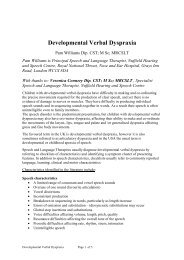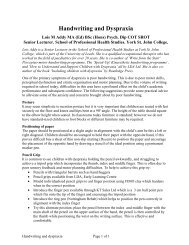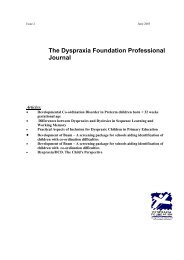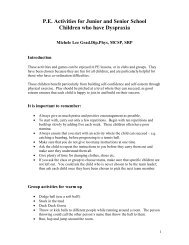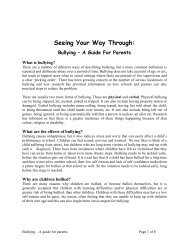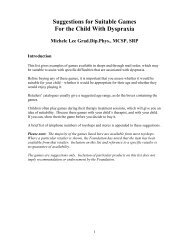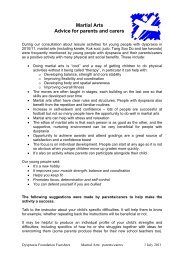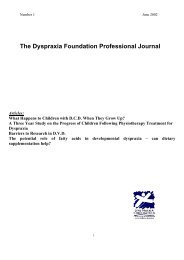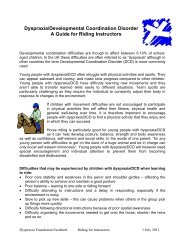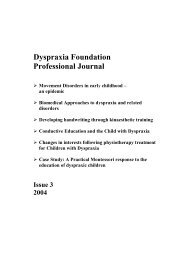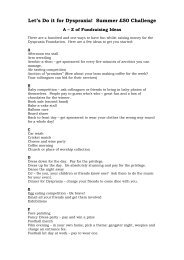Employers Guide - Dyspraxia Foundation
Employers Guide - Dyspraxia Foundation
Employers Guide - Dyspraxia Foundation
You also want an ePaper? Increase the reach of your titles
YUMPU automatically turns print PDFs into web optimized ePapers that Google loves.
<strong>Dyspraxia</strong> <strong>Foundation</strong> <strong>Guide</strong> For <strong>Employers</strong><br />
Visual Differences<br />
What are visual differences?<br />
Many people wear glasses to rectify focusing<br />
problems. Other visual difficulties may not be<br />
so easily solved. Problems in eye/brain<br />
co-ordination may cause visual stress,<br />
especially in the work place where efficient<br />
vision is essential. Visual difficulties may be a<br />
feature of hidden disabilities and these<br />
difficulties need to be recognised and<br />
addressed.<br />
The eyes and the brain work together to<br />
create vision. There is a great deal of research<br />
analysing the complexities of the way this<br />
works and sometimes doesn’t work.<br />
Difficulties may occur due to ‘mechanical’ or<br />
optical problems.<br />
An optician or behavioural optometrist should<br />
be able to identify these, and often provide<br />
some mechanical correction.<br />
However if the difficulty is associated with how<br />
the brain interprets visual information it may<br />
need to be identified by a specialist teacher,<br />
psychologist or occupational therapist. It may<br />
be related to unresolved visual stress difficulties<br />
and may create difficulties in the workplace,<br />
which can often be resolved with simple<br />
solutions.<br />
If there is any sudden visual difficulty further<br />
investigation is strongly recommended.<br />
How can visual differences affect people in<br />
the work place?<br />
• Blurring and/or double vision when<br />
reading.<br />
• Tiredness or fatigue after close or<br />
intensive work.<br />
• Headaches, eyestrain or nausea when<br />
reading.<br />
• Eye rubbing or blinking with visual<br />
exertion.<br />
• Short working spans.<br />
• Poor concentration and distractibility.<br />
• Closing or covering one eye whilst<br />
working.<br />
• Colours may be seen in the text.<br />
• Pattern, glare or grids may be seen in<br />
the text.<br />
• Misaligned digits in number columns.<br />
• Problems keeping place when reading,<br />
tendency to skip lines<br />
• Need for a finger or marker to keep<br />
place.<br />
• Excessive head movements whilst<br />
reading.<br />
• Lack of comprehension whilst reading.<br />
• Slow reading speed.<br />
• Letter or number reversal or omission.<br />
• Visual discomfort when reading large<br />
amounts.<br />
• Misreading information.<br />
• Poor recognition of precise shapes,<br />
colours, size.<br />
• Difficulty in retaining shape in memory.<br />
• Inability to visualise words.<br />
• Bad letter formation and recognition.<br />
• Visual transport problems i.e. difficulty<br />
when copying.<br />
• Cannot tell that a word “looks wrong”<br />
and difficulty with proof reading.<br />
Produced by Key 4 Learning Ltd



